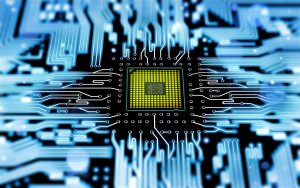Electronics and Software in Product Design & Development
 In this latest article in our series which examines the services and technologies that complement – and are critical to – commercial product design, we’re going to look at software and electronics design and development.
In this latest article in our series which examines the services and technologies that complement – and are critical to – commercial product design, we’re going to look at software and electronics design and development.
Our previous articles have covered:
- Using SolidWorks CAD software to create the product design
- Protecting your Intellectual Property with patent law
- The increasing use of Virtual Reality in design
- The role of and technologies available for Prototyping of new product designs
Any product with a software or hardware component built into it will require these electronic elements to be scoped, designed and tested, as well as integrated into the overall product design.
As with all integral elements of a product, the electronics are ideally designed in from the very beginning of the product development project, and to fulfil this requirement, Cambridge Design Technology has formed a valuable strategic partnership with long-time embedded systems specialist D.C. Allen.
Here we’re going to examine the process for developing the electronic components of a new product design, considering embedded systems development in particular, and concluding with the evaluation, verification and validation process.
Electronics and software development in the product design process
Any product which includes an electronic element, from a simple consumer item such as a temperature controller to a complex medical device such as an intravenous pump, will require these components to be designed and integrated into the overall product.
The electronics and software elements should be detailed in a functional specification document that describes the purpose and functionality of the device or technology, and which also describes the usability, operability, control, management, safety and performance requirements.
Depending on the type and purpose of the product, device or technology, the electronic element is likely to involve one or more of the following:
- One or mor
 e microprocessors
e microprocessors - Digital and analogue circuits
- Wireless devices
- Sensors
- User interface (displays etc)
- Motor control
- Software
The process
The approach to electronics and particularly software design is highly structured because virtually all of the functionality and complexity of many modern day products are encapsulated in the software. Ensuring product safety is always the most important aspect of the development process, whether the product is a medical, mechanical, industrial or consumer product.
A typical process would follow these stages:
- Concept: needs assessment and research
- Product requirements: the production of a functional requirements specification
- Plan: development of a detailed project plan
- Design: system and schematic design, PCB layout, mechanisms and assemblies
- Development: hardware, software and other components
- Prototype: first manufacture of the design, and iteration if required
- Verification and testing: to ensure the electronic design meets all necessary regulatory requirements
- Full technical documentation
Embedded systems design
 When designing electronics and software for use in embedded systems, the key for the engineer is to understand how the hardware and software elements of the product will interface with each other to perform the required manual or automated functions.
When designing electronics and software for use in embedded systems, the key for the engineer is to understand how the hardware and software elements of the product will interface with each other to perform the required manual or automated functions.
Embedded systems are found in all manner of standalone products from medical devices, industrial and IT products through to consumer products.
Embedded systems include intelligence (microprocessors or microcontrollers) with on-board software (firmware) that provides the core functionality of the product. Almost all embedded systems incorporate some form of user interface.
The functions can be mechanical or electrical, and the embedded systems can range from the simple to the highly complex – hence the requirement for a detailed requirements specification right at the very beginning.
The components of embedded systems are:
- Hardware
- Microprocessors
- Memory
- User interface (LED, LCD, touchscreen, keypad etc)
- Interfaces and ports
- Sensors
- Analog to digital converters
- Timers
- Power supplies
- Software
- Real time operating system
- Interface layers
- Application layers
Embedded systems are used in medical, aerospace, automotive, telecommunications, networking, transportation and manufacturing – in fact there’s barely a sector in which embedded systems don’t have a role.
In terms of pure volume though, the consumer electronics sector alone is responsible for many billions of devices with embedded systems.
Smart phones, games consoles, cameras and remote control devices such as drones, household devices such as fridges and dishwashers, heating and cooling systems and security and surveillance account for the vast majority of these systems.
Embedded systems for sensing and controlling are set to be a major growth area with the Internet of Things (IoT) billed as the ‘next big thing’ in technology.
Verification and validation
 In order to ensure product quality, an important element of electronics development work is the verification and validation stage, during which the functions of the electronic system are tested in order to identify and correct conditions under which the device does not meet the product requirements.
In order to ensure product quality, an important element of electronics development work is the verification and validation stage, during which the functions of the electronic system are tested in order to identify and correct conditions under which the device does not meet the product requirements.
Verification and validation is important to ensure that:
- The product functions in accordance with the original requirements specification;
- The product does not present an unacceptable risk to the end user;
- The product meets the needs and expectations of the end user;
- The product meets all necessary regulatory requirements.
Most electronics and software design projects are managed in accordance with – and in full expectation of – the testing and evaluation stage being a rigorous process, so by the time the design gets to this point there should be very few surprises.
One of the objectives of the verification and validation stage is the generation of a documentation set that demonstrates that all necessary and required testing has taken place and that all the requirements have been met.
As well as testing obvious factors such as code integrity and functionality, the verification and validation stage should also cover the effects of misuse, component tolerances and failure modes.
Cambridge Design Technology in partnership with DC Allen
Cambridge Design Technology recommend DC Allen to all our clients for electronics and software requirements – including embedded systems development – in the full confidence that they will receive quality of technology and service from one of the leading firms in their field.
We have worked with DC Allen for 25 years on a broad range of projects which have required embedded systems work.
Established in 1962, DC Allen is a product design and development consultancy specialising in electronic systems for healthcare, instrumentation and signal processing applications.
Based in Poole, England, the firm serves an international client base ranging from start-ups to multinational corporations.
Focussing on embedded systems, instrumentation and control, DC Allen have a proven track record of engineering solutions to meet customers’ requirements, on-time and on-budget.
Speaking of their relationship with Cambridge Design Technology, Tim Allen, Managing Director of DC Allen says:
“We have worked with Jon Plumb for 25 years or more, including during his 12 years with Innovate 3.
“Our first project together was a high successful drug delivery system for Baxter Healthcare, which was an outstanding success.
“We continue to be impressed with the work of Cambridge Design Technology and are happy to refer clients to Jon and his team when appropriate.”
For more information about Cambridge Design Technology or any of the prototyping technologies mentioned here, or just to discuss your next product or engineering design project, please call Jon Plumb now on 01787 377106 or email info@cambridge-dt.com

 e microprocessors
e microprocessors


